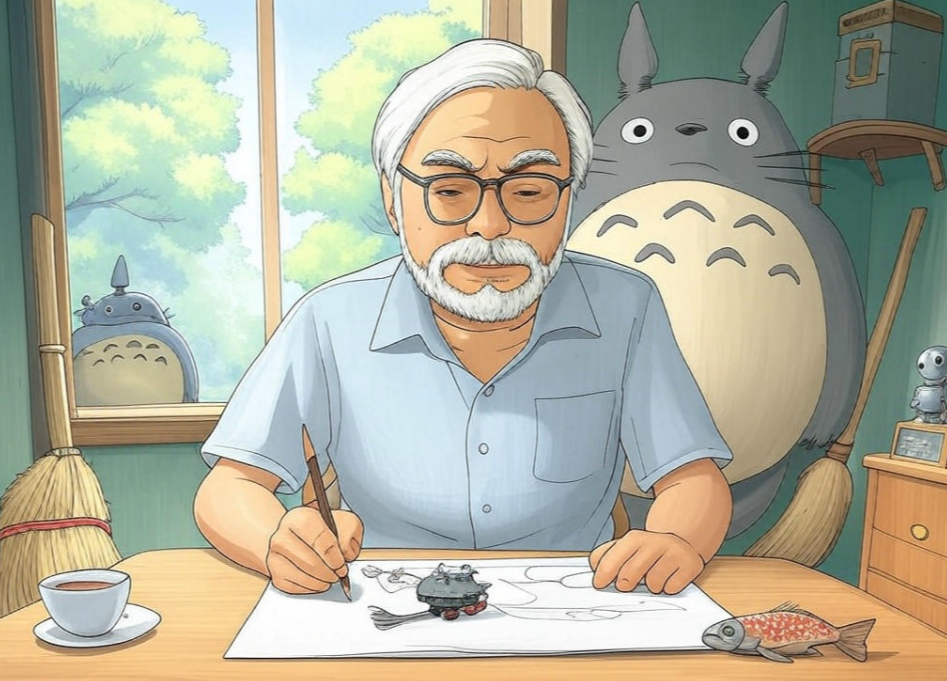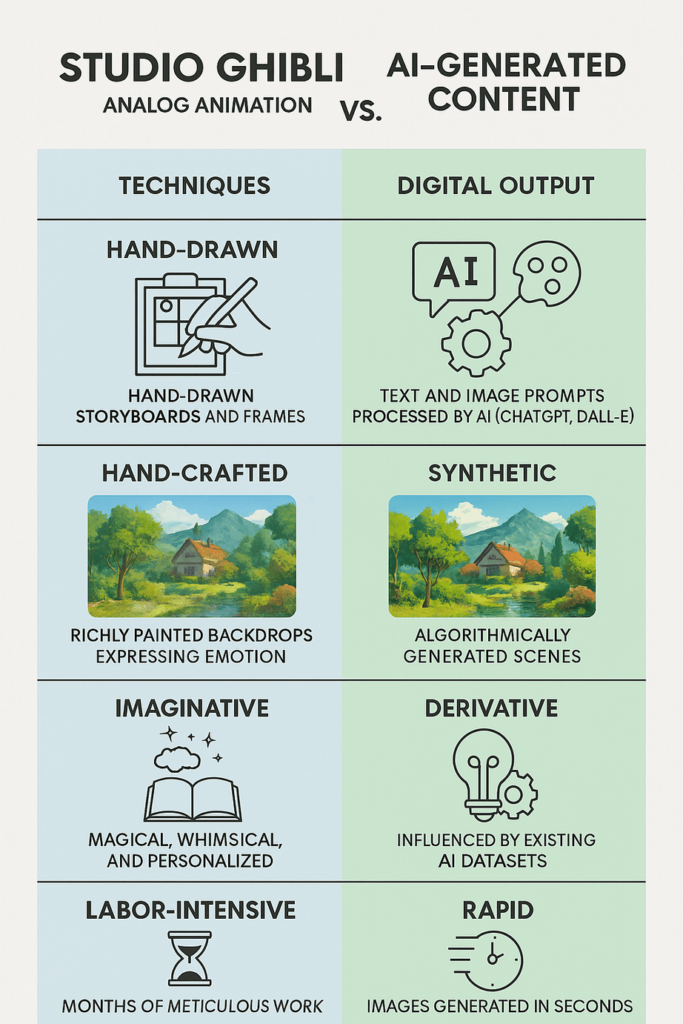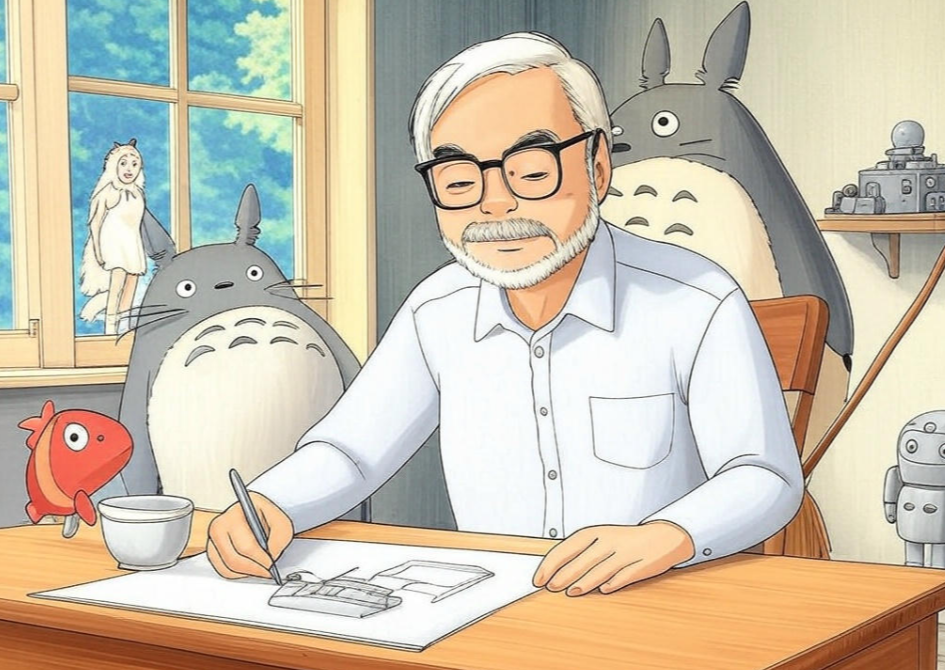4/1/2025
Studio Ghibli: Where Hand-Drawn Dragons Battle AI Algorithms
(And Why Miyazaki Would Rather Fight a Forest Spirit)
In an age where AI-generated cat memes flood X with unsettlingly realistic whiskers and ChatGPT pens wedding vows about “synergistic love paradigms” that sound like corporate buzzword bingo gone rogue, Studio Ghibli stands as a defiant fortress of analog enchantment. Picture a world where dragons aren’t 3D-rendered by soulless algorithms but painstakingly hand-drawn, frame by frame, with the kind of care usually reserved for grandma’s secret noodle recipe. Witches don’t just cackle—they deliver pizzas on broomsticks. Grumpy old men don’t just grumble—they bellow at clouds with the fury of a thousand thunderstorms. This is the domain of Hayao Miyazaki, the Gandalf of animation, a man who’d sooner arm-wrestle a kodama (those clattering, wide-eyed forest sprites from Princess Mononoke) than let an AI anywhere near his sacred storyboards.
This is the tale of Studio Ghibli: a studio so stubbornly anti-CGI it makes your grandma’s flip phone look like a SpaceX rocket booster mid-launch. A place where Miyazaki’s retirement announcements are as trustworthy as a weather report from Howl’s Moving Castle’s ever-shifting skyline. So grab a steaming bowl of ramen—because Ponyo would pout if you didn’t—and settle in for a whirlwind journey through the gloriously chaotic, whimsically hand-crafted universe of Japan’s animation titans.
Chapter 1: Miyazaki—The Man, The Myth, The Reluctant Retirement Legend

Hayao Miyazaki is the Willy Wonka of animation, if Wonka swapped the chocolate rivers for chain-smoking marathons and a vendetta against capitalism so fierce it could power a windmill. Born in 1941 in wartime Japan, Miyazaki grew up with a front-row seat to humanity’s messier tendencies—bombed-out cities, post-war recovery, and a father who worked on fighter plane parts. Little wonder his films oscillate between pastoral wonderlands and apocalyptic dread. His career kicked off in the ‘60s when he was hired to animate a Little Mermaid knockoff—ironic, considering Disney would later dub his masterpieces with the enthusiasm of a kid discovering sugar.
But Miyazaki’s true legacy began in 1985 when he co-founded Studio Ghibli with director Isao Takahata (the quiet yin to Miyazaki’s fiery yang) and producer Toshio Suzuki (the glue holding these creative tornadoes together). The name “Ghibli” comes from an Italian term for a hot Saharan wind, a nod to Miyazaki’s dream of blowing a fresh breeze through the stagnant anime industry. It also sounds suspiciously like “jibbly,” which perfectly captures the existential wobble you feel after sobbing through Grave of the Fireflies.
Miyazaki’s work ethic is the stuff of legend—or possibly a cautionary tale for labor unions. He’s “retired” roughly seven times since 1997, each declaration greeted with the same skepticism fans reserve for Fast & Furious “final chapters” or your uncle’s promise to quit karaoke. His latest “last” film, The Boy and the Heron (2023), is a semi-autobiographical fever dream about a boy, a bird, and enough existential baggage to fill a moving castle. Critics hailed it as a masterpiece; fans just nodded knowingly, expecting Miyazaki to emerge from “retirement” any day now with a pencil in one hand and a rant about modernity in the other. Rumor has it his real retirement plan is to haunt the Ghibli Museum as a benevolent ghost, eternally tweaking storyboards and muttering about the evils of digital shortcuts.
Chapter 2: Studio Ghibli—Where Every Frame is a Labor of Love (And Mild Insanity)
Studio Ghibli’s films are the polar opposite of AI-generated sludge. While ChatGPT can churn out a script faster than you can say “prompt overload,” Ghibli’s artists spend months hand-painting watercolor backgrounds so lush you can practically smell the moss. They animate individual blades of grass swaying in the breeze, each frame a tiny rebellion against the cold efficiency of CGI. Their process is so meticulous it makes The Lord of the Rings’ production diaries look like a TikTok dance tutorial thrown together in five minutes.
The Ghibli Method, Unpacked:
- Storyboarding: Miyazaki sketches thousands of panels by hand, often scrapping entire plots midstream because a cloud didn’t feel “spiritual” enough. It’s like J.K. Rowling rewriting Harry Potter post-publication because she decided Hermione should’ve ridden a dragon instead of a broom.
- Background Art: Every scene’s backdrop is painted in gouache, a medium so retro it’s basically the vinyl record of art supplies. These aren’t just backgrounds—they’re love letters to nature, from the shimmering rivers of Spirited Away to the windswept dunes of Nausicaä of the Valley of the Wind.
- Character Animation: Animators draw each frame on paper, a process so labor-intensive it’s said some grew beards—or lost them—while animating the lumbering, creaking legs of Howl’s Moving Castle. No motion-capture suits here—just caffeine, pencils, and sheer willpower.
The attention to detail is borderline unhinged. Take the food scenes: the glistening rice balls in My Neighbor Totoro, the sizzling bacon in Howl’s Moving Castle, the slurpable ramen in Ponyo. They’re animated with such precision that fans have jokingly threatened to sue theaters for not serving snacks to match. (Okay, they haven’t, but the petition’s probably circulating on X as we speak.) This isn’t animation—it’s a culinary seduction disguised as a cartoon.
Chapter 3: The Ghibli Aesthetic—Whimsy, Trauma, and Food Porn
Ghibli’s films defy categorization. They’re a glorious mishmash of:
- Wholesome AF: Think fluffy forest spirits (Totoro’s rotund charm), plucky heroines (Kiki zipping through the sky), and cats who moonlight as bus drivers (The Cat Returns). It’s comfort food for the soul, served with a side of nostalgia.
- Existential Dread: Environmental ruin (Nausicaä), war’s toll (The Wind Rises), and parents morphing into literal pigs (Spirited Away). Ghibli doesn’t shy away from the dark stuff—it just wraps it in a pretty bow.
- Food So Real You Can Taste It: That bacon-and-egg breakfast in Howl’s Moving Castle has launched more brunch orders than any Instagram influencer’s #FoodPorn post. The jiggling jelly in Ponyo? You’ll swear it’s wobbling on your plate.
Why does it work? Ghibli thrives on contradictions. It’s like biting into a vegan burger that somehow outshines a juicy ribeye—you don’t question the alchemy; you just savor the delicious confusion. Miyazaki’s worlds are equal parts escape and mirror, reflecting our dreams and fears with a hand-painted brushstroke. One minute you’re cooing at a soot sprite; the next, you’re pondering humanity’s inevitable collapse. It’s emotional whiplash, Ghibli-style.
Chapter 4: Ghibli vs. AI—The Battle for the Soul of Art
Fast-forward to 2023, when ChatGPT users started prompting the AI to “write a Studio Ghibli-style story.” The results were predictably absurd: tales of “a lonely robot who befriends a sentient teapot” or “a wind-powered mech piloted by a pacifist raccoon.” Miyazaki would probably hate them—then quietly adapt one into an Oscar-winning epic about the teapot’s tragic backstory.
The irony is thicker than Calcifer’s flames. Ghibli’s analog charm has become a muse for the digital age. AI tools like DALL-E churn out Ghibli-esque landscapes—rolling hills, glowing fireflies, suspiciously Totoro-shaped clouds—while ChatGPT spins yarns about eco-warrior witches and grumpy forest gods. Miyazaki, who once famously called AI animation “an insult to life itself” after watching a grotesque AI-generated demo, is likely drafting a 10-page manifesto titled Why Robots Can’t Draw Trees Properly. (Spoiler: It’s because they lack souls.)
Ghibli’s Unofficial AI Policy:
- No Robots Allowed: Unless they’re the clunky, endearing kind from Castle in the Sky, preferably with moss growing on their joints.
- Keep It Hand-Drawn: Even if it takes a decade and 500 animators who’ve forgotten what sunlight looks like.
- Environmental Subtext Mandatory: All AI-generated Ghibli knockoffs must feature at least one scene where a tree punches a capitalist polluter in the face—or at least grows aggressively in their direction.
The battle lines are drawn: Ghibli’s human heart versus AI’s cold efficiency. Spoiler alert: Miyazaki’s still winning, one pencil stub at a time.
Chapter 5: The Ghibli Fandom—From Totoro Tattoos to AI Memes
Ghibli fans are a species unto themselves, a delightful mix of dreamers, eccentrics, and people who take their cosplay very seriously. They’re the ones who:
- Cosplay as No-Face: Turning a faceless, gluttonous blob into a runway-ready icon, complete with a coin purse and existential vibes.
- Build Ghibli Shrines: Homes decked out with soot sprites crafted from lint rollers, Totoro plushies, and DIY Calcifer fire pits (hopefully not actually flammable).
- Weaponize ChatGPT: Fanfic like “Kiki’s Delivery Service Meets Mad Max” exists, and it’s a chaotic masterpiece—think Kiki air-dropping bread bombs on a post-apocalyptic wasteland.
But there’s a dark side. Some fans have fed entire Ghibli scripts into AI tools, hoping to generate sequels. The results? My Neighbor Totoro 2: Totoro vs. Mechagodzilla, where the big fluffball flattens Tokyo with a belly flop, or Spirited Away: The Blockchain Bathhouse, where Chihiro mines crypto to free Haku. Miyazaki’s reaction? Picture a silent, withering headshake that could wilt a forest.
The fandom’s creativity is boundless, but it’s a double-edged sword. For every heartwarming Totoro tattoo, there’s an AI-generated abomination lurking on X, waiting to haunt your nightmares.
Chapter 6: The Future—Ghibli in the Age of AI Overlords
What lies ahead for Studio Ghibli in a world increasingly dominated by AI?
- Miyazaki’s 8th Retirement: Followed by his 9th comeback to direct The Animator Who Un-Retired, a meta masterpiece about a cranky old man who can’t stop drawing.
- AI Collaborations (Against Their Will): Picture a ChatGPT-penned Princess Mononoke spin-off where Ashitaka opens a sustainable yak farm, or a DALL-E-rendered Totoro that looks like a taxidermy experiment gone wrong.
- The Ghibli Cinematic Universe (GCU): Because every studio needs one. Porco Rosso teams up with Ponyo to fight climate change via aerial fish delivery. Kiki and Howl open a magical bakery. Post-credits scene: Totoro devours the villain, burps, and naps.
The real question: Can Ghibli stay true to its roots as AI encroaches? Miyazaki’s successors—like his son Goro (From Up on Poppy Hill)—face the Herculean task of honoring the hand-drawn legacy while dodging the siren call of digital shortcuts. Fans hold their breath, chopsticks poised over ramen bowls, waiting to see if the magic endures.
Studio Ghibli’s Analog Animation vs. AI-Generated Content: A Tale of Tradition vs. Technology
In a world where AI is becoming a driving force behind art, storytelling, and even film production, there stands a legendary animation studio that has steadfastly stuck to its roots: Studio Ghibli. Known for its whimsical, hand-drawn animations, Ghibli has shaped the animation world with painstaking attention to detail and a passion for traditional techniques. On the other hand, artificial intelligence, particularly tools like ChatGPT and DALL-E, are rapidly changing the landscape of content creation, offering solutions that are quicker, cost-effective, and highly innovative. But what happens when you compare the meticulous craftsmanship of Ghibli’s analog animation methods to the cutting-edge AI tools that are becoming increasingly common in the creative industries?
Studio Ghibli’s Analog Animation Process: A Labor of Love

Studio Ghibli, founded in 1985 by Hayao Miyazaki and Isao Takahata, has earned a reputation for creating stunning animated films that evoke deep emotional responses. One of the key factors that distinguishes Ghibli from other animation studios is its hand-drawn animation technique. Every frame is meticulously created by animators using traditional tools, such as pencils, inks, and paints.
The process is slow and labor-intensive, requiring a small army of skilled animators to bring Miyazaki’s detailed storyboards to life. First, Ghibli’s animators work on storyboarding, mapping out every scene of the film. These storyboards serve as the skeleton of the animation, ensuring that the director’s vision is translated onto paper. Once the storyboard is finalized, the backgrounds are carefully painted using traditional gouache or watercolor paints, a technique that gives Ghibli films their signature ethereal quality.
The animation itself is done frame by frame, with each character movement drawn individually. This attention to detail results in beautifully fluid and organic animation, from the rustling of leaves to the intricate movements of creatures like the Kodama in Princess Mononoke. Ghibli’s commitment to this painstaking process, despite the growth of digital technology, is a testament to the studio’s dedication to preserving the artistry of animation.
AI-Generated Content: Speed and Innovation
On the other side of the spectrum, AI-generated content is rapidly becoming a game-changer in the creative industries. Tools like ChatGPT and DALL-E have democratized content creation by enabling anyone with a basic understanding of how to prompt these systems to generate written content, images, and even videos.
ChatGPT, for example, can write scripts, stories, poems, and dialogue almost instantaneously. It uses massive amounts of data to learn language patterns and create narratives that can range from short paragraphs to entire books. The model is trained on a variety of content, allowing it to mimic different writing styles, tones, and formats. Unlike traditional scriptwriters, who spend days or weeks crafting scripts, ChatGPT can produce a fully-formed draft in mere seconds, significantly reducing production times.
Similarly, DALL-E—a model developed by OpenAI—uses AI to create images based on textual descriptions. DALL-E is capable of generating photorealistic images or artistic renderings in a matter of seconds, from a description as simple as “a robot made of clouds” to more complex imagery like “an underwater city glowing with neon lights.” This technology has opened new possibilities for artists, designers, and creators who can now generate high-quality visuals without needing traditional art skills or equipment.
Contrasting Approaches: Tradition vs. Technology
While Studio Ghibli’s analog methods focus on human creativity and meticulous craftsmanship, AI-generated content is primarily driven by automation and efficiency. In Ghibli’s case, every frame, every line of dialogue, and every scene is an act of artistic expression. It’s a labor of love that involves human hands and minds working together to craft something timeless and unique. The results are films that feel deeply personal and are filled with emotion and soul.
AI-generated content, however, thrives on speed and scalability. Tools like ChatGPT and DALL-E have transformed the way stories are told and images are created, enabling creators to produce vast amounts of content in record time. However, the quality of AI-generated art often lacks the emotional depth and intentionality that comes from human creators. The nuance and imperfections that make art feel alive are often missing in AI-generated works.
Where Do We Go from Here?
The contrast between Studio Ghibli’s analog animation and AI-generated content brings up an essential question: can AI ever replace the artistry and soul of traditional animation? While AI has certainly made great strides in producing realistic content, it still lacks the inherent human touch that makes art so compelling. The imperfections, subtlety, and personalization found in traditional animation are aspects that AI is far from replicating.
However, it’s possible that the two worlds may merge. For example, Ghibli might one day use AI to help with certain tasks, like background painting or inking, while still keeping the core of the animation process hand-drawn. Likewise, the storytelling methods of Miyazaki could inspire future AI models to create narratives that capture the same magic and emotional depth.
In conclusion, while Studio Ghibli’s analog animation will always stand as a benchmark for creativity, artistry, and dedication, AI-generated content represents a new frontier in creative efficiency and accessibility. Both have their strengths, and it will be fascinating to see how they coexist and evolve in the coming years.
Conclusion: Why Ghibli Will Outlive Us All
In a world where AI churns out content faster than you can say “algorithmic bias,” Studio Ghibli remains the slow-cooked ramen of storytelling—a labor-intensive, soul-warming reminder that true magic can’t be automated. Miyazaki may despise AI with the heat of a thousand Calcifers, but his films have unwittingly become its muse. And isn’t that the ultimate irony? The man who’d rather burn his sketchbook than let a robot draw a tree has inspired a digital renaissance of whimsy.
So the next time ChatGPT spits out a Ghibli-inspired tale about a “robotic raccoon who saves a forest,” take a moment to smile—then imagine Miyazaki hunched over his desk, sketching a rebuttal one frame at a time. In the end, Ghibli’s not just a studio—it’s a stubborn, beautiful testament to the human hand, heart, and a little bit of madness. Long may it reign, one hand-painted cloud at a time.
Ready to create a Ghibli Image?
